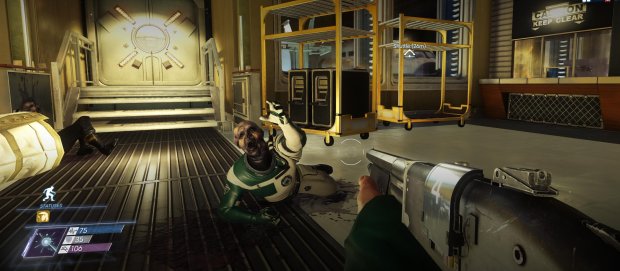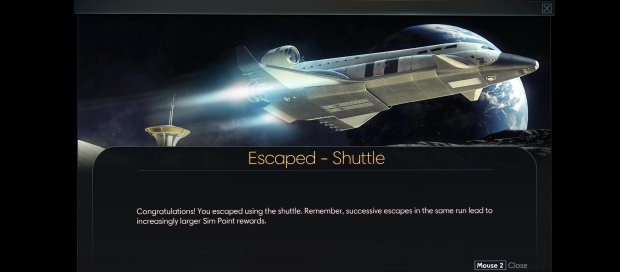Prey: Mooncrash offers a surprising amount to do in a deceptively small space
Lunarcy
Prey: Mooncrash is a game of refinement. It's a piece of DLC that uses an economy of space by asking you to replay the same sprawling collection of areas repeatedly, with varying characters, varying skillsets, and an ever-changing threat to combat. It's a game that will make you play Prey differently than you have before, and you'll be grateful of it.
You begin in a simulation room, under vague circumstances, tasked with fixing a couple of bits and bobs to get the simulator running. That done, you're in, and playing as one of five characters you'll gradually unlock, attempting to escape from a devastated moon base overrun by Prey's gang of alien antagonists.
To do this, you'll use all of Prey's weaponry and tactics, plus some that are either new, or I never found them in the main game. Gloo bombs, for instance, as a cousin of the Gloo gun. And each character is designed to best exploit a different aspect of Prey's paraphernalia, with unique skill trees to expand.
There are five different ways to escape the moon base, from the super-simple escape pod route you'll aim to reach on your first run, to far more elaborate means such as launching a rocket, which, well, requires you to know how to fly a rocket. And as you explore the really sizeable number of locations on offer here, you'll gather new information, new key cards, and be able to exploit your skills in specific ways.
Die - and you will die - and you start over. Either from scratch if you've run out of survivors to play as, or picking up with the next character to continue on in the simulation in the state you left it. The ultimate goal of the game is to get all five characters to leave the base using all five methods, in a single run.
But that's going to take a lot of playing before it's possible. First you're going to have to work out how to unlock all the characters, then how to reach all the escape routes, and then get each character powered up enough with upgrades and Psi options such that it is possible. And to do that, you're going to need to run each character a few times.
Upgrades last over death, and even resets of the simulation. (In fact, "reset" is a pretty inaccurate term here, since the sim maintains many of the changes you'll have caused through repeated plays. For an early example, you begin the first time in a small room heavily staffed by disguised mimics, but on further plays that's all cleared out and the door's opened, so saves the tedium of repeating the same simple actions each time.) As indeed do fabrication plans (items you can make in the fabricators), and the sim points you gain. These are used to buy items from previous runs to have in your inventory at the start of the next.
This is a neat device, meaning you don't need to start with a measly wrench each time out, but rather can equip yourself with a couple of decent weapons, some repairs, and even spend a fortune on some neuromods. Then there are chipsets, more minor upgrades, that require repurchasing from your gathered pool each time. But, of course, also means you can't spam the game, as you need to earn more sim points to be able to do this each time. Such points are earned mostly just by playing - discoveries, kills, repairs, and so on.
The result is a sort of first-person metroidvania roguelite, if you'll forgive such extravagances. As you charge about trying to stay alive, you'll find computers that require level three hacking, or machines needing a level three repair, and such abilities are another 8 neuromods away from level two. You note them down for later attempts, as you keep replaying these locations.
And if that concerns you, you worry you'll get too used to the same places, even with the variety it offers, then I have two responses. First, I've been playing it a load, and despite assuming the same, it hasn't happened yet. And secondly, multiplayer games. Mooncrash's reuse of the same spaces with differing characters is a single-player rendering of that familiar multiplayer notion, where the spaces are interesting enough when combined with the changes in enemies, enemy placements, and tools available, to sustain it.
And, like multiplayer gaming, a good deal of Mooncrash is about perfecting your skills within that environment. While you won't know what enemies you'll face where in any given run, you'll start to learn your way around the labyrinthine base, and be able to pick your route more deliberately, exploiting shortcuts and hideouts you've learned.
But what's absolutely smartest about Mooncrash is how it requires you to play as those five different characters. Because it's forcing me to play a single-player first-person-me-do in ways I usually avoid. Like anyone, there are ways I lean to in any immersive sim, preferring stealth, hacking and repairing over bombs and run-n-gun bravado. But here, as you play each archetype, you're required to change your play-style accordingly. It's making me approach Prey's world in a way I haven't before, and that's refreshing and interesting.
I must say, I've yet to care a jot about the plot. Lots of work has gone in, as you'd expect from Arkane, with emails and notes and recordings and fragmented remains of banter, and the voice acting is superb. But I've yet to find a single bit of it interesting enough to remember. I do wish this were more engaging, such that it became another prong to motivate replaying.
It's still pretty infuriating that it peculiarly features two loading screens, one after the other, each time you change areas. The only other issue I've faced is some proper framerate issues in the game's initial simulation room, but once out of there it ran smoothly at 60fps.
Mooncrash also introduces some of the new optional content for the main game, including weapon degradation, and specific body traumas that then need to be healed. The former is a bit of a naff inconvenience, really. For no discernible reason, your guns get worn out at an astonishing pace through use (I don't know anything about guns, but I'm pretty sure they last more than a day). The traumas are more interesting. Get injured in particular ways and you're hobbled until addressed. Sometimes this limits how much health can be restored, but more interestingly, it might mean you can't sprint or jump without incurring further injury, forcing you to quickly adapt how you play in that moment.
I'm still going with this, crashing and sneaking and leaping and flailing through the interconnecting sectors, and being absolutely properly terrified of the new Moonshark monstrosity that haunts the central hub. Whether it will hold my attentions long enough to persist to try to get all five off the base in a single run seems a lot less likely, but I'm having a great time for now.
Mooncrash is an enormous paddling pool compared to Prey's Olympic swimming pool. There's none of the depth, but it's a heck of a good time to splash around in.
Prey: Mooncrash is out now on Windows, for £13/$20/20€, via Steam - it requires the full version of Prey















